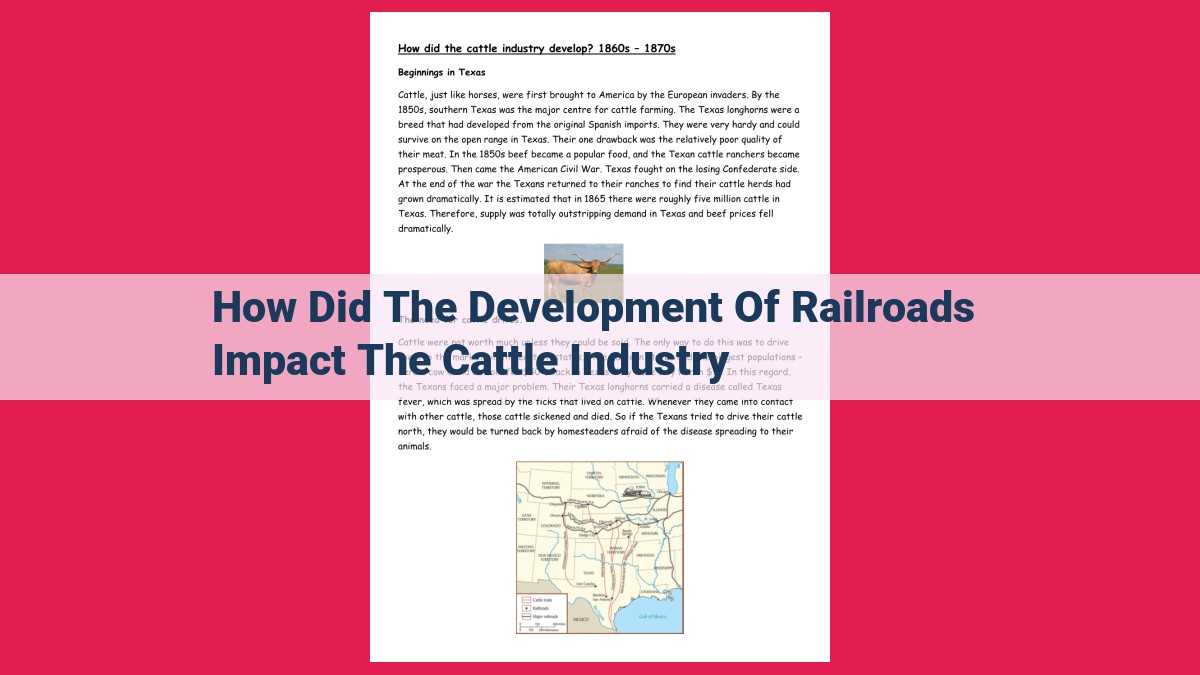The Transformative Impact Of Railroads On The Cattle Industry: Revolutionizing Transportation, Production, And Consumption

The advent of railroads revolutionized the cattle industry by drastically reducing transportation time and expanding cattle reach. This enabled the establishment of sprawling ranches to meet growing urban demand. Efficient distribution and refrigeration techniques via railroads increased beef consumption. National markets standardized prices and reduced local market fluctuations, while faster shipping facilitated selective breeding practices, improving livestock quality. Railroads transformed livestock practices, contributing to the modern beef production industry.
The Cattle Industry: A Railroad Revolution
Before the advent of the iron horse, the cattle industry was a tale of limitations and arduous journeys. Cattle roamed vast, open ranges, their movements dictated by the seasons and the search for sustenance. Ranchers herded their stock on foot, enduring treacherous trails and vulnerable to the whims of nature and rustlers. However, everything changed with the advent of the railroad.
Sub-Heading 1: The Transportation Revolution
Traditional methods of cattle transportation were slow and arduous. Animals were driven long distances, often losing weight and value along the way. But railroads offered a solution. They reduced transit times significantly, enabling cattle to reach markets faster and in better condition. They also expanded the reach of the cattle industry, connecting remote ranches to distant cities and opening up new markets.
Transportation Revolution: A Catalyst for the Cattle Industry’s Transformation
Before the advent of railroads, the cattle industry faced significant limitations. Traditional methods of transportation, such as driving herds on foot or using horse-drawn wagons, were slow, inefficient, and costly. Cattle drives often took months, exposing animals to harsh conditions and disease.
Railroads revolutionized cattle transport by drastically reducing travel time and expanding reach. Cattle could now be transported across vast distances in days instead of weeks or months. This not only improved the well-being of the animals but also made it possible to transport larger quantities of cattle to new markets.
The increased speed and efficiency of rail transport spurred the growth of large cattle ranches. Ranchers could now reach distant markets more quickly and cost-effectively, allowing them to expand their operations and meet the growing demand for beef. Additionally, railroads opened up new markets for cattle, such as urban centers that were previously inaccessible due to transportation constraints.
The Railroad’s Role in Expanding the Cattle Industry
Prior to the advent of railroads, the cattle industry faced significant constraints, with transportation being a major obstacle. Cowboys relied on slow and arduous cattle drives along trails that often stretched hundreds of miles, leading to high losses and limited market reach.
Railroad Revolution: Expanding Cattle Ranching
The arrival of railroads transformed the cattle industry by drastically reducing transportation times and expanding the reach of markets. As trains became increasingly efficient, cattlemen recognized the opportunity to establish large-scale ranches that could meet the growing demand for beef. By shipping their livestock to distant markets, ranchers could capitalize on higher prices and tap into untapped consumer bases.
Exploring New Horizons: Opening Untapped Markets
Railroads not only enabled the expansion of existing ranches but also paved the way for the exploration of new markets. Before railroads, cattle drives were constrained by geography, limiting the distribution of beef to local areas. However, trains allowed for the transportation of livestock over long distances, connecting ranchers to major urban centers and creating a national market for cattle.
As a result, the cattle industry surged, becoming a major economic driver in the United States. Railroads played a crucial role in the rise of the Great Plains ranching empire, where vast tracts of land were dedicated to cattle grazing. The expansion of the industry brought prosperity to rural areas and helped meet the growing demand for affordable beef.
Beef on the Rails: The Transformation of Beef Consumption
Before the advent of railroads, beef was a luxury enjoyed primarily by those living in close proximity to cattle ranches. Transportation was arduous and slow, making it impractical to ship cattle long distances. The meat would often spoil before reaching its destination.
The railroad revolutionized the cattle industry by dramatically reducing transportation time and expanding the reach of cattle markets. This led to a surge in the establishment of large cattle ranches in the West, which were able to meet the growing demand for beef in urban centers.
The development of efficient distribution and refrigeration techniques enabled by railroads played a crucial role in making beef more accessible to urban consumers. Before the railroad era, beef would often have to be slaughtered near its point of origin, as it would spoil quickly during the long journey.
Railroads made it possible to transport live cattle to slaughterhouses in urban centers, where they could be processed and distributed quickly. This ensured that consumers had access to fresh, quality beef, regardless of their location.
In addition to making beef more accessible, railroads also helped to standardize prices and reduce market fluctuations. Prior to the railroad era, the price of beef could vary significantly depending on the local supply and demand. However, railroads created national markets for cattle, allowing for the efficient distribution of beef and the establishment of more consistent prices.
The availability of fresh, affordable beef in urban centers led to a significant increase in beef consumption. This increase in demand fueled the growth of the cattle industry and had a profound impact on American cuisine and culture.
Market Competition: Nationalizing the Cattle Market
Railroads played a pivotal role in revolutionizing the cattle industry, not only by expanding its reach but also by creating a national market. Prior to the railroad era, cattle were primarily traded and sold in local markets, resulting in significant price fluctuations and limited competition.
With the advent of railroads, cattle transportation became faster and more reliable. This enabled cattlemen to transport their livestock to distant markets, expanding the geographic reach of their operations. Furthermore, railroads standardized shipping rates, eliminating previous disparities between local markets, making prices more uniform across the country.
Increased competition had beneficial effects on the industry. Previously isolated markets were now connected, allowing buyers to compare prices and negotiate for the best deals. Cattlemen, in turn, had to offer competitive prices to attract customers. This pressure fostered innovation and efficiency, driving the industry toward modernization.
The national market created by railroads also stabilized prices and reduced the impact of seasonal fluctuations and local droughts. This stability provided cattlemen with a more predictable and sustainable income, enabling them to invest in their operations and improve their herds.
In conclusion, the railroads’ nationalization of the cattle market had a profound impact on competition. It standardized prices, increased competition, spurred innovation, and provided stability to the industry. These developments laid the foundation for the modern livestock industry and contributed to the affordable and abundant supply of beef we enjoy today.
Improved Livestock Quality: A Railroad Revolution
Transportation of Breeding Stock and Genetic Material
Prior to the railroad era, the transportation of breeding stock was a laborious and risky endeavor. Cattle were driven long distances over rough terrain, often leading to injury or death. The development of railroads provided a safe and efficient way to transport valuable breeding stock across vast distances. Railroads allowed breeders to exchange genetic material, introducing new bloodlines and improving the quality of cattle.
Facilitating Selective Breeding Practices
The speed and reliability of railroads also revolutionized selective breeding practices. Ranchers could quickly and easily ship animals to specific locations for breeding purposes. This enabled them to compare different bloodlines, select the highest-quality animals, and breed for desired traits, such as weight gain, carcass quality, and disease resistance. Railroads made it possible to establish breeding programs on a national scale, resulting in significant improvements in livestock quality.
The transportation of breeding stock and genetic material via railroads was a transformative element in the cattle industry. It facilitated the exchange of genetic material, introducing new bloodlines and improving the quality of cattle. The speed and reliability of railroads also enabled selective breeding practices, allowing ranchers to breed for desired traits and establish national breeding programs. These advancements laid the foundation for modern livestock practices and contributed significantly to the production of high-quality beef today.





